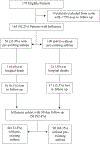Association of Asthma With Treatments and Outcomes in Children With Critical Influenza
- PMID: 36379408
- PMCID: PMC10006305
- DOI: 10.1016/j.jaip.2022.10.045
Association of Asthma With Treatments and Outcomes in Children With Critical Influenza
Abstract
Background: Hospitalization for severe influenza infection in childhood may result in postdischarge sequelae.
Objective: To evaluate inpatient management and postdischarge sequelae in children with critical respiratory illness owing to influenza with or without preexisting asthma.
Methods: This was a prospective, observational multicenter study of children (aged 8 months to 17 years) admitted to a pediatric intensive care or high-acuity unit (in November 2019 to April 2020) for influenza. Results were stratified by preexisting asthma. Prehospital status, hospital treatments, and outcomes were collected. Surveys at approximately 90 days after discharge evaluated postdischarge health resource use, functional status, and respiratory symptoms.
Results: A total of 165 children had influenza: 56 with preexisting asthma (33.9%) and 109 without it (66.1%; 41.1% and 39.4%, respectively, were fully vaccinated against influenza). Fifteen patients with preexisting asthma (26.7%) and 34 without it (31.1%) were intubated. More patients with versus without preexisting asthma received pharmacologic asthma treatments during hospitalization (76.7% vs 28.4%). Of 136 patients with 90-day survey data (82.4%; 46 with preexisting asthma [33.8%] and 90 without it [66.1%]), a similar proportion had an emergency department/urgent care visit (4.3% vs 6.6%) or hospital readmission (8.6% vs 3.3%) for a respiratory condition. Patients with preexisting asthma more frequently experienced asthma symptoms (78.2% vs 3.3%) and had respiratory specialist visits (52% vs 20%) after discharge. Of 109 patients without preexisting asthma, 10 reported receiving a new diagnosis of asthma (11.1%).
Conclusions: Respiratory health resource use and symptoms are important postdischarge outcomes after influenza critical illness in children with and without preexisting asthma. Less than half of children were vaccinated for influenza, a tool that could mitigate critical illness and its sequelae.
Keywords: Acute respiratory viral infection; Asthma; Influenza; Outcomes; Pediatric intensive care unit; Reactive airway disease.
Copyright © 2022 American Academy of Allergy, Asthma & Immunology. Published by Elsevier Inc. All rights reserved.
Conflict of interest statement
Figures




Comment in
-
Challenges and Opportunities in Asthma Prevention and Treatment.J Allergy Clin Immunol Pract. 2023 Mar;11(3):748-749. doi: 10.1016/j.jaip.2022.12.032. J Allergy Clin Immunol Pract. 2023. PMID: 36894276 No abstract available.
-
Influenza: A Bad Illness for Children With (or Without) Asthma.J Allergy Clin Immunol Pract. 2023 Apr;11(4):1198-1199. doi: 10.1016/j.jaip.2023.02.024. J Allergy Clin Immunol Pract. 2023. PMID: 37030925 No abstract available.
References
-
- Campbell AP, Ogokeh C, Lively JY, Staat MA, Selvarangan R, Halasa NB, et al. Vaccine Effectiveness Against Pediatric Influenza Hospitalizations and Emergency Visits. Pediatrics 2020; 146. - PubMed
-
- Past seasons estimated influenza disease burden. National Center for Immunization and Respiratory Diseases (NCIRD); 2020.] Available from https://www.cdc.gov/flu/about/burden/2019-2020.html.
-
- Olson SM, Newhams MM, Halasa NB, Feldstein LR, Novak T, Weiss SL, et al. Vaccine Effectiveness Against Life-Threatening Influenza Illness in US Children. Clin Infect Dis 2022. - PubMed
-
- Ferdinands JM, Olsho LE, Agan AA, Bhat N, Sullivan RM, Hall M, et al. Effectiveness of influenza vaccine against life-threatening RT-PCR-confirmed influenza illness in US children, 2010–2012. J Infect Dis 2014; 210:674–83. - PubMed
Publication types
MeSH terms
Grants and funding
LinkOut - more resources
Full Text Sources
Medical
Miscellaneous

